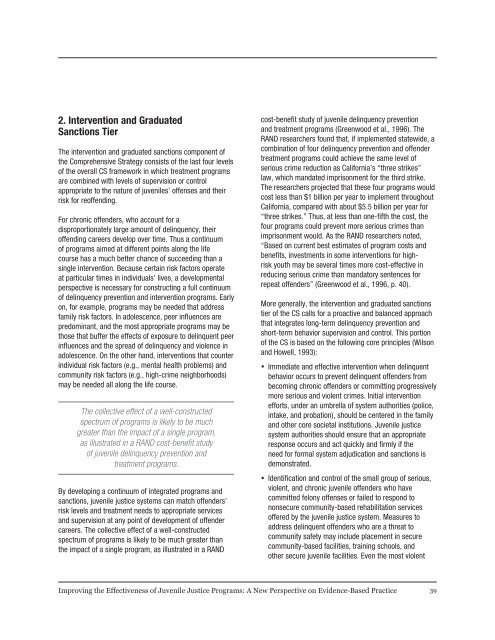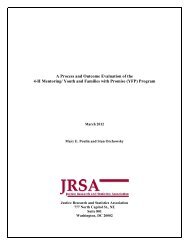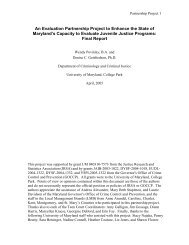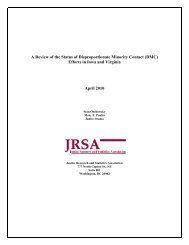Improving the Effectiveness of Juvenile Justice Programs: A New
Improving the Effectiveness of Juvenile Justice Programs: A New
Improving the Effectiveness of Juvenile Justice Programs: A New
Create successful ePaper yourself
Turn your PDF publications into a flip-book with our unique Google optimized e-Paper software.
2. Intervention and Graduated<br />
Sanctions Tier<br />
The intervention and graduated sanctions component <strong>of</strong><br />
<strong>the</strong> Comprehensive Strategy consists <strong>of</strong> <strong>the</strong> last four levels<br />
<strong>of</strong> <strong>the</strong> overall CS framework in which treatment programs<br />
are combined with levels <strong>of</strong> supervision or control<br />
appropriate to <strong>the</strong> nature <strong>of</strong> juveniles’ <strong>of</strong>fenses and <strong>the</strong>ir<br />
risk for re<strong>of</strong>fending.<br />
For chronic <strong>of</strong>fenders, who account for a<br />
disproportionately large amount <strong>of</strong> delinquency, <strong>the</strong>ir<br />
<strong>of</strong>fending careers develop over time. Thus a continuum<br />
<strong>of</strong> programs aimed at different points along <strong>the</strong> life<br />
course has a much better chance <strong>of</strong> succeeding than a<br />
single intervention. Because certain risk factors operate<br />
at particular times in individuals’ lives, a developmental<br />
perspective is necessary for constructing a full continuum<br />
<strong>of</strong> delinquency prevention and intervention programs. Early<br />
on, for example, programs may be needed that address<br />
family risk factors. In adolescence, peer influences are<br />
predominant, and <strong>the</strong> most appropriate programs may be<br />
those that buffer <strong>the</strong> effects <strong>of</strong> exposure to delinquent peer<br />
influences and <strong>the</strong> spread <strong>of</strong> delinquency and violence in<br />
adolescence. On <strong>the</strong> o<strong>the</strong>r hand, interventions that counter<br />
individual risk factors (e.g., mental health problems) and<br />
community risk factors (e.g., high-crime neighborhoods)<br />
may be needed all along <strong>the</strong> life course.<br />
The collective effect <strong>of</strong> a well-constructed<br />
spectrum <strong>of</strong> programs is likely to be much<br />
greater than <strong>the</strong> impact <strong>of</strong> a single program,<br />
as illustrated in a RAND cost-benefit study<br />
<strong>of</strong> juvenile delinquency prevention and<br />
treatment programs.<br />
By developing a continuum <strong>of</strong> integrated programs and<br />
sanctions, juvenile justice systems can match <strong>of</strong>fenders’<br />
risk levels and treatment needs to appropriate services<br />
and supervision at any point <strong>of</strong> development <strong>of</strong> <strong>of</strong>fender<br />
careers. The collective effect <strong>of</strong> a well-constructed<br />
spectrum <strong>of</strong> programs is likely to be much greater than<br />
<strong>the</strong> impact <strong>of</strong> a single program, as illustrated in a RAND<br />
cost-benefit study <strong>of</strong> juvenile delinquency prevention<br />
and treatment programs (Greenwood et al., 1996). The<br />
RAND researchers found that, if implemented statewide, a<br />
combination <strong>of</strong> four delinquency prevention and <strong>of</strong>fender<br />
treatment programs could achieve <strong>the</strong> same level <strong>of</strong><br />
serious crime reduction as California’s “three strikes”<br />
law, which mandated imprisonment for <strong>the</strong> third strike.<br />
The researchers projected that <strong>the</strong>se four programs would<br />
cost less than $1 billion per year to implement throughout<br />
California, compared with about $5.5 billion per year for<br />
“three strikes.” Thus, at less than one-fifth <strong>the</strong> cost, <strong>the</strong><br />
four programs could prevent more serious crimes than<br />
imprisonment would. As <strong>the</strong> RAND researchers noted,<br />
“Based on current best estimates <strong>of</strong> program costs and<br />
benefits, investments in some interventions for highrisk<br />
youth may be several times more cost-effective in<br />
reducing serious crime than mandatory sentences for<br />
repeat <strong>of</strong>fenders” (Greenwood et al., 1996, p. 40).<br />
More generally, <strong>the</strong> intervention and graduated sanctions<br />
tier <strong>of</strong> <strong>the</strong> CS calls for a proactive and balanced approach<br />
that integrates long-term delinquency prevention and<br />
short-term behavior supervision and control. This portion<br />
<strong>of</strong> <strong>the</strong> CS is based on <strong>the</strong> following core principles (Wilson<br />
and Howell, 1993):<br />
• Immediate and effective intervention when delinquent<br />
behavior occurs to prevent delinquent <strong>of</strong>fenders from<br />
becoming chronic <strong>of</strong>fenders or committing progressively<br />
more serious and violent crimes. Initial intervention<br />
efforts, under an umbrella <strong>of</strong> system authorities (police,<br />
intake, and probation), should be centered in <strong>the</strong> family<br />
and o<strong>the</strong>r core societal institutions. <strong>Juvenile</strong> justice<br />
system authorities should ensure that an appropriate<br />
response occurs and act quickly and firmly if <strong>the</strong><br />
need for formal system adjudication and sanctions is<br />
demonstrated.<br />
• Identification and control <strong>of</strong> <strong>the</strong> small group <strong>of</strong> serious,<br />
violent, and chronic juvenile <strong>of</strong>fenders who have<br />
committed felony <strong>of</strong>fenses or failed to respond to<br />
nonsecure community-based rehabilitation services<br />
<strong>of</strong>fered by <strong>the</strong> juvenile justice system. Measures to<br />
address delinquent <strong>of</strong>fenders who are a threat to<br />
community safety may include placement in secure<br />
community-based facilities, training schools, and<br />
o<strong>the</strong>r secure juvenile facilities. Even <strong>the</strong> most violent<br />
<strong>Improving</strong> <strong>the</strong> <strong>Effectiveness</strong> <strong>of</strong> <strong>Juvenile</strong> <strong>Justice</strong> <strong>Programs</strong>: A <strong>New</strong> Perspective on Evidence-Based Practice<br />
39

















